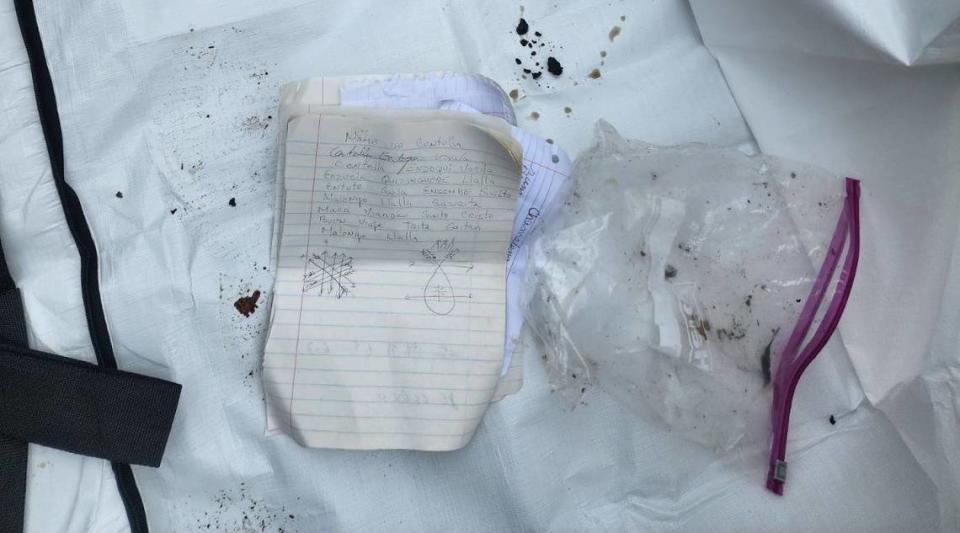Human skull found in a historic Macon cemetery. Could it be from an ancient ritual?
It takes a lot to disturb a man who checks on dead bodies for a living.
The life of a coroner is one wrought with upsetting imagery, but something about the scene found on Wednesday morning at Macon’s historic Rose Hill Cemetery off Riverside Drive was different for Bibb County Coroner Leon Jones.
Perhaps it felt eerie because, Jones said, an apparent human skull was found placed in a bucket, along with a note written in another language.
Jones said he was unnerved from the moment he saw the skull, which was found by a local man and was flanked in the dirt by what appeared to be a bird’s head, a rubber snake and other odd artifacts.
“I’ve never had a feeling like that, ever,” Jones said. “I’ve seen over 10,000 dead bodies. I’ve been in a house with someone who’s been dead for months. But I have never been in a situation where it was creepy like that.”
The man who found the skull at about 11:45 a.m. Wednesday called Jones, then reported it to the cemetery and the Department of Parks and Recreation. Jones and others went to the scene, which was further in the rear of the historic cemetery than Jones had ever been before.

“We had to take this long flight of stairs down after a long walk, we were almost down at the river,” Jones said. “I had never been back that far before, I don’t know why (the man who found the skull) was back there, but we found it.”
The feeling in the group changed when they came across the skull, according to Jones. Despite the fact that they’d just trekked through a cemetery without much issue, he suddenly became uncomfortable.
“It was like some kind of ritual,” Jones said. “We saw all these sticks in the bucket and the other stuff, and it was just an eerie feel to it.”
There’s no official word from law enforcement on how old the skull might be, how long it had been there, or true confirmation of where it came from, though Jones thinks someone brought it to the cemetery and put it there in the ritual-like format it was found in. The GBI took the skull to its crime lab, where it will undergo testing to answer these questions.
The bucket, as shown in photos provided by Jones, is cauldron-like — a wide, black vessel that pitches outward at the top and is wrapped in what looks like a red ribbon. Accompanying the bucket and the items within was a small piece of paper with scrawlings in another language.
One phrase written on the sheet, “endoqui varilo,” registers as Latin on Google Translate. It simply reads “smallpox,” the software says.
One of Jones’ instincts when he saw the skull was that it may have been some kind of ritual. Anthropologist Tony Kail, who talked to Jones about the photos of the skull, agreed.
Kail has a master’s degree in cultural anthropology and has written books on African-Latin religious traditions. He said the way the skull was placed with sticks, paired with the words written on the paper, very closely resembles a traditional shrine from the Bantu people, a group of more than 400 ethnic tribes mainly hailing from southern Africa.
“Among the Bantu people of Africa there is a healer known as a Nganga. The healer uses things like dirt, bones, soil, plants and trees in order to provide medicines to the community,” Kail told the Telegraph in an email. “In the pot traditionally there are 21 branches from different trees, and there is usually a form of bone, whether that be animal or in some cases human. In this case, the human bone represents ancestors and the dead.”
Kail said this ritual, which apparently originates in the Congo region of Africa specifically, was likely passed down when slaves were brought to areas like Cuba, then spread to America.
He also said many people still practice this religion now in the southern U.S., but often do so discreetly because of what he calls “misunderstandings” about the faith.
While the GBI autopsy results for the skull remain open, Kail’s analysis and Jones’ report of the scene prove one thing — at the very least, it was quite a memorable find.
“There are a few things I’ll never forget,” Jones said. “I’ll never forget (the murder of law student) Lauren Giddings. I’ll never forget one car crash on I-475 that left a family burned. And I’m really never going to forget this.”

